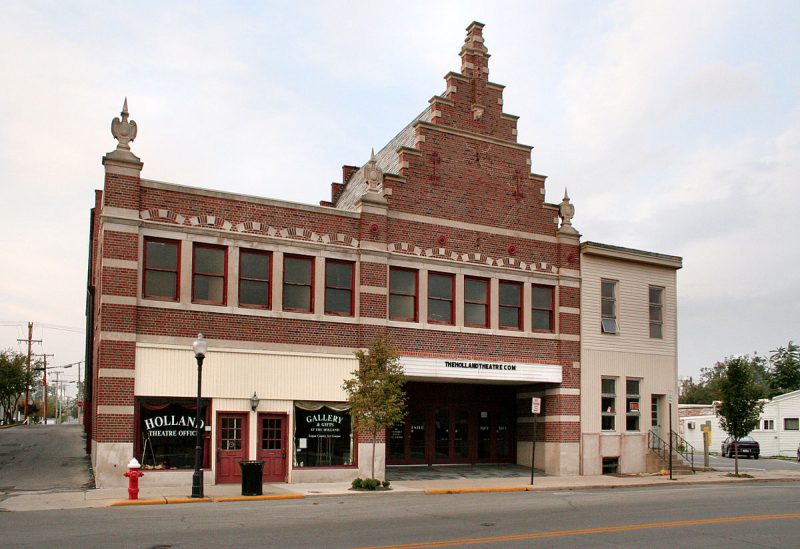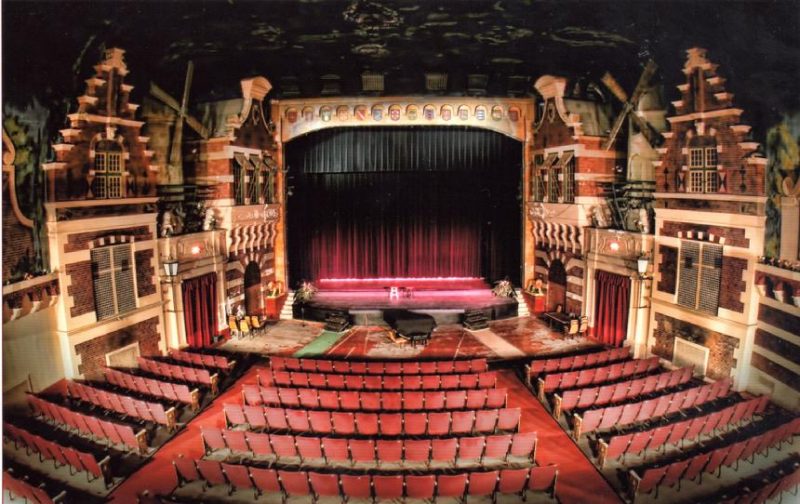Bellefontaine – Holland Theatre
Historic Theaters
CASE Studies


Current Name of Theater: Holland Theatre
Current Type: Atmospheric theatre
Seats: 1,200 / 1 screen
Website: http://thehollandtheatre.org/
Historic Names of Theater: P
Address: 127 E Columbus Ave, Bellefontaine, OH 43311
Contact:
Phone: (937) 592-9002
Email: office@thehollandtheatre.net
Year Built/Style: 1931 / Dutch Atmospheric Theatre
Original Architect: Schine Brothers of the Schine Circuit Theaters, hired the architect Peter M. Hulsken
Original Cost:
Listed on National Register: yes
NRHP Reference # 01000561
Added to NRHP – May 25, 2001
History of Theater:
Cost of Rehabilitation:
Architect: Hoseler Bros.
Contractors:
Source of Funds:
Renovation Story: In 1998 the Holland was closed as a movie house
The Holland Theatre is a unique atmospheric theatres. Designed by Holland-born architect Peter M. Hulsken, the auditorium was inspired by his Dutch birth place. The design was patented (copy righted) and remains a one of a kind design. No other Dutch atmospheric theatre can be found in the United States and possibly the world. The outside of the theatre boasts a stepped gable front and the Dutch cross bond pattern of bricks which would look at home on the streets of Amsterdam. The inside of the auditorium has a ceiling that looked like an evening sky, with twinkling stars and moveable clouds. The walls are adorned with a façade of windmills (whose sails rotate), canal houses with lighted windows, and tulip filled window boxes. Shields from Dutch cities decorate the proscenium arch and the balcony and two majestic lions guard the stage. Nowhere else can a theatre be found in this nation that transforms a small town in Ohio into an old street scene in Holland.
The Holland Theatre, like most old movie houses, fell on hard times with the advancement of technology. The Holland saw many owners, all of which tried to meet the needs of the public, with changes to the theatre. It was multiplexed in an attempt to compete with the newer theatres. Through it all the changes were made with respect to the theatre’s design and the integrity of the design was maintained. In 1998 the Holland was closed as a movie house. It was feared that the Holland would fall to the wrecking ball.
In 1999, with the help of many concerned citizens and a group of gifted local junior high students, the wheels were set in motion to reopen and restore this beautiful structure. The Logan County Landmark Preservation, Inc. was formed and with their hard work and the support of the community, even in this time of financial hardship, the Holland is thriving as a venue for the performing arts and a home for the visual arts. The fact that the Theatre is being restored and is active is a testament to the importance and historical significance of the Holland. It remains a vital cog in the heart of this small rural community. The Holland is a monument to our past and a significant part of our future.
In the early days of moving pictures, American entertainment companies vied for market share by offering their films in opulent theaters. Going to the movies was an event. Men wore their Sunday suits for the occasion; women donned their hats and stockings; and films were shown in movie “palaces”, lush fantasy lands filled with velvet-covered seats and crystal chandeliers. For the price of a forty-cent ticket, moviegoers not only would be transported into the celluloid world, but also could enjoy the type of extravagant surroundings usually reserved for the very wealthy.
American theatre architecture peaked in the 1920’s. Hundreds of elaborate movie palaces were built across the United States in towns both large and small. Often these theatres were constructed in an atmospheric style. They resembled Italian piazzas, Grecian ruins, and Moorish courtyards. As patrons found their seats, Corinthian columns, classical facades, and tastefully draped statues of coy Roman goddesses flanked them. Mosaic tiled fountains sang in the lobbies and coming feature posters were hung in gilded frames. The Italian and Spanish styles were very popular, and many of the remaining theaters were built with those contrivances. However, a single historic atmospheric theatre stands out among the dozens listed on the National Register of Historic Places and on the rolls of the Theatre Historical Society of America — Bellefontaine’s historic Holland Theatre.
Schine Enterprises, a family company that built and operated about 150 theatres in six states, built the Holland Theatre in downtown Bellefontaine, Ohio, in 1931. The Schine’s Holland Theatre in Bellefontaine is the only Dutch-style atmospheric theater in the United States, and perhaps the only one existing in the world. The Holland Theatre not only represents a nostalgic part of Logan County’s past, but it also offers new opportunities for the county’s future.
From the outside, the Holland Theatre has not changed dramatically since it was built. The exterior of the Theatre is attractive rose-colored brick. The three story structure has a stepped, Flemish-style gable that gives only a hint of as to what awaited movie-goers inside when the Theatre was in its heyday. Although the lobby and main foyer of the Holland has been cosmetically altered through the decades, originally both spaces introduced the Dutch theme with its hewn timber framed beams, heavy plastered walls, and reproductions of famous Dutch paintings hung between field-paneled walls.
While 1,400 patrons sat in air-conditioned or heated comfort, they did so as their eyes told them they were outdoors. The interior auditorium was designed as a convincing representation of a 17th-century Dutch cityscape. Blooming tulips waved gently in window boxes as two working windmills quietly stirred the air. The brick and timber-framed facades were careful reproductions, nearly actual sized, of known buildings – one of which was the family home of the Holland’s architect, Peter Hulsken. Windows in these facades were dimly lit from within, giving the impression that building’s interiors were illuminated by candlelight. The ceiling was painted a deep blue, and tiny lights simulated flickering stars. A cloud machine completed the effect. The largest movie screen in Ohio, 40-feet long, filled the stage.
On December 28,1999, The Historic Holland Theatre was purchased for the Logan County Landmark Preservation, Inc. by Richard and Peggy Knowlton.
![]()

